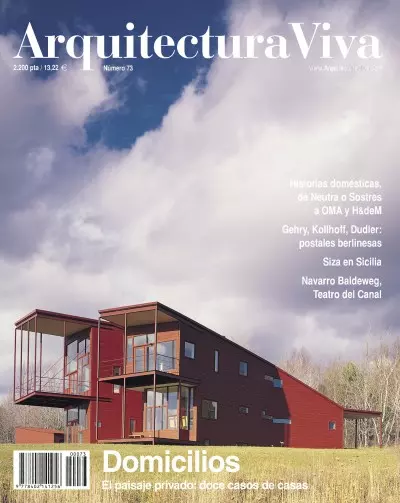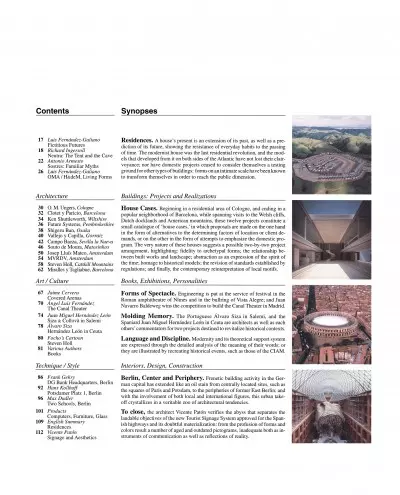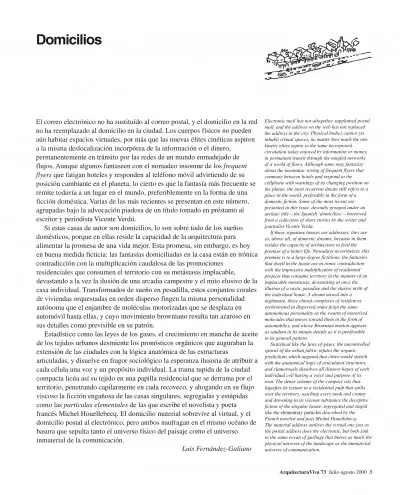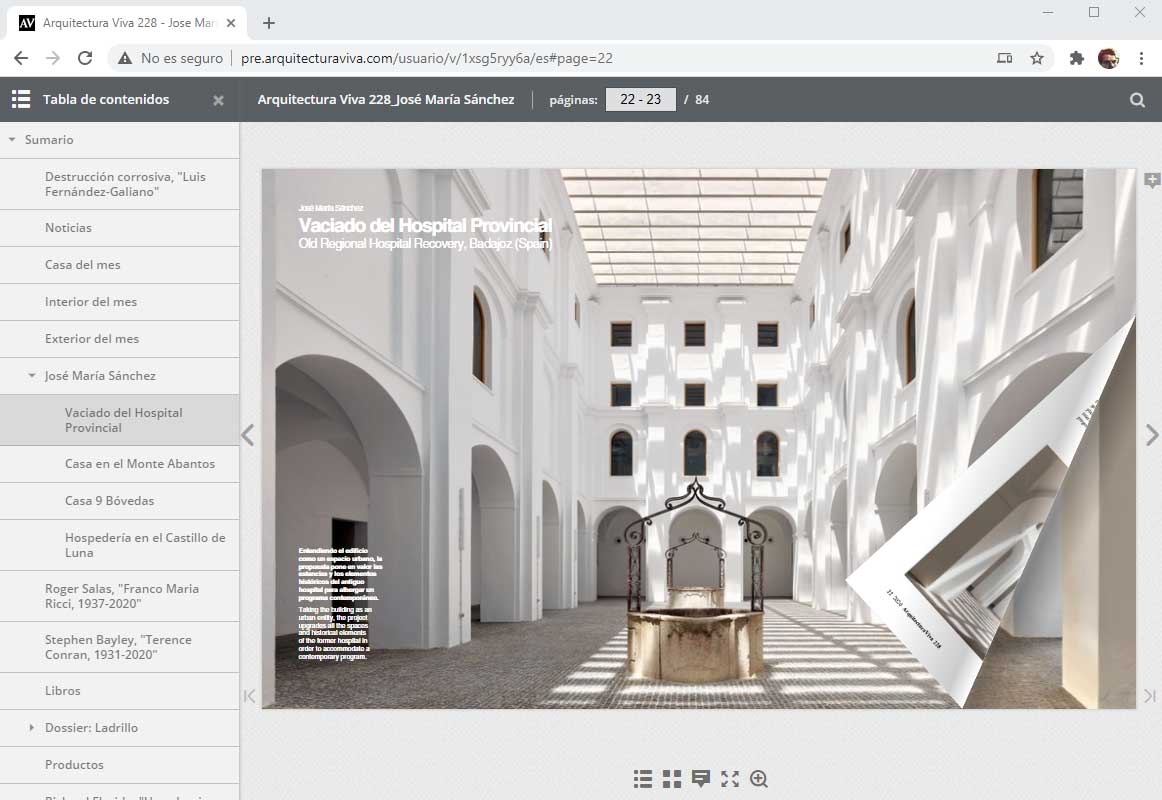Contents
Residences.. A house’s present is an extension of its past, as well as a prediction of its future, showing the resistance of everyday habits to the passing of time. The modernist house was the last residential revolution, and the models that developed from it on both sides of the Atlantic have not lost their clairvoyance; nor have domestic projects ceased to consider themselves a testing ground for other types of buildings: forms on an intimate scale have been known to transform themselves in order to reach the public dimension.
Synopses
Luis Fernández-Galiano
Fictitious Futures
Richard Ingersoll
Neutra: The Tent and the Cave
Antonio Armesto
Sostres: Familiar Myths
Luis Fernández-Galiano
OMA and H&dM, Living Forms
Buildings: Projects and Realizations
House Cases. Beginning in a residential area of Cologne, and ending in a popular neighborhood of Barcelona, while spanning visits to the Welsh cliffs, Dutch docklands and American mountains, these twelve projects constitute a small catalogue of ‘house cases,’ in which proposals are made on the one hand in the form of alternatives to the determining factors of location or client demands, or on the other in the form of attempts to emphasize the domestic program. The very nature of these houses suggests a possible two-by-two project arrangement, highlighting: fidelity to archetypal forms; the relationship between built works and landscape; abstraction as an expression of the spirit of the time; homage to historical models; the revision of standards established by regulations; and finally, the contemporary reinterpretation of local motifs.
Architecture
O.M. Ungers, Cologne
Clotet y Paricio, Barcelona
Ken Shuttleworth, Wiltshire
Future Systems, Pembrokeshire Shigeru Ban, Osaka
Vallejo y Capilla, Gorraiz
Campo Baeza, Sevilla la Nueva
Souto de Moura, Matosinhos
Josep Lluís Mateo, Amsterdam
MVRDV, Amsterdam
Steven Holl, Catskill Mountains
Miralles y Tagliabue, Barcelona
Books, Exhibitions, Personalities
Forms of Spectacle. Engineering is put at the service of festival in the Roman amphitheatre of Nîmes and in the bullring of Vista Alegre; and Juan Navarro Baldeweg wins the competition to build the Canal Theater in Madrid. Art / Culture
Jaime Cervera
Covered Arenas
Ángel Luis Fernández
The Canal TheaterMolding Memory. The Portuguese Álvaro Siza in Salemi, and the Spaniard Juan Miguel Hernández León in Ceuta are architects as well as each others’ commentators for two projects destined to revitalize historical contexts. Juan Miguel Hernández León
Siza & Collovà in Salemi
Álvaro Siza
Hernández León in CeutaLanguage and discipline. Modernity and its theoretical support system are expressed through the detailed analysis of the meaning of their words; or they are illustrated by recreating historical events, such as those of the CIAM.
Focho’s Cartoon
Steven Holl
Various Authors
Books
Interiors, Design, Construction
Berlín, Center and Periphery. Frenetic building activity in the German capital has extended like an oil stain from centrally located sites, such as the squares of Paris and Potsdam, to the peripheries of former East Berlin; and with the involvement of both local and international figures, this urban takeoff crystallizes in a veritable zoo of architectural tendencies. Technique / Style
Frank Gehry
DG Bank Headquarters, Berlín
Hans Kollhoff
Potsdamer Platz 1, Berlín
Max Dudler
Two schools, BerlínTo close, the architect Vicente Patón verifies the abyss that separates the laudable objectives of the new Tourist Signage System approved for the Spanish highways and its doubtful materialization: from the profusion of forms and colors result a number of aged and outdated pictograms, inadequate both as instruments of communication as well as reflections of reality. Products
Computers, Furniture, Glass
English Summary
Residences
Vicente Patón
Signage and Aesthetics
Luis Fernández-Galiano
Residences
Electronic mail has not altogether supplanted postal mail, and the address on the web has not replaced the address in the city. Physical bodies cannot yet inhabit virtual spaces, no matter how much the new kinetic elites aspire to the same incorporeal circulation today enjoyed by information or money, in permanent transit through the tangled networks of a world of flows. Although some may fantasize about the insomniac roving of frequent flyers that commute between hotels and respond to the cellphone with warnings of its changing position on the planet, the most recurrent dream still refers to a place in the world, preferably in the form of a domestic fiction. Some of the most recent are presented in this issue, devoutly grouped under an archaic title – the Spanish ‘domicilios’ – borrowed from a collection of short stories by the writer and journalist Vicente Verdú.
If these signature houses are addresses, they are so, above all, of domestic dreams. because in them resides the capacity of architecture to feed the promise of a better life. Nowadays nevertheless, this promise is to a large degree fictitious: the fantasies that dwell in the house are in ironic contradiction with the impressive multiplication of residential projects that consume territory in the manner of an implacable metastasis, devastating at once the illusion of a rustic paradise and the elusive myth of the individual house. A dream turned into a nightmare, these choral complexes of residences orchestrated in dispersed order feign the same autonomous personality as the swarm of motorized molecules that moves toward them in the form of automobiles, and whose Brownian motion appears as random in its minute details as it is predictable in its general pattern..
Statistical like the laws of gases, the uncontrolled sprawl of the urban fabric refutes the organic predictions which augured that cities would stretch with the anatomical logic of articulated structures, and clamorously dissolves all illusory hopes of each individual cell having a voice and purpose of its own. The dense scheme of the compact city thus liquefies its texture in a residential pulp that spills over the territory, reaching every nook and cranny and drowning in its viscous substance the deceptive fiction of the singular house, segregated and stupid like the elementary particles described by the French novelist and poet Michel Houellebecq. The material address outlives the virtual one just as the postal address does the electronic, but both sink in the same ocean of garbage that buries as much the physical universe of the landscape as the immaterial universe of communication..








